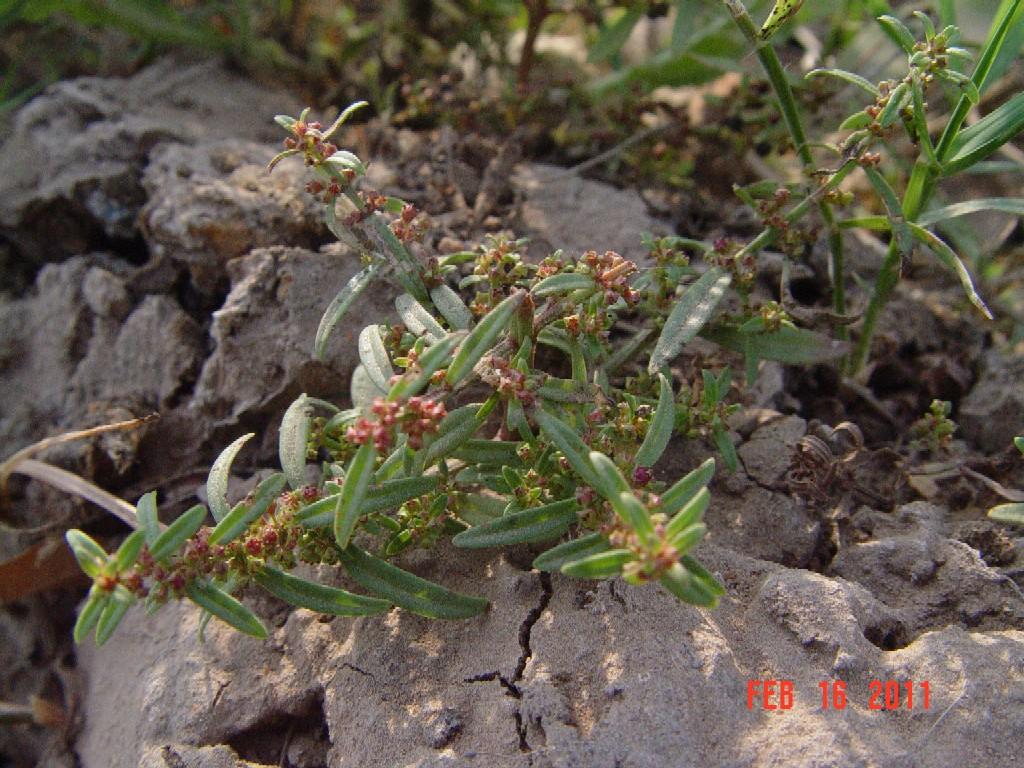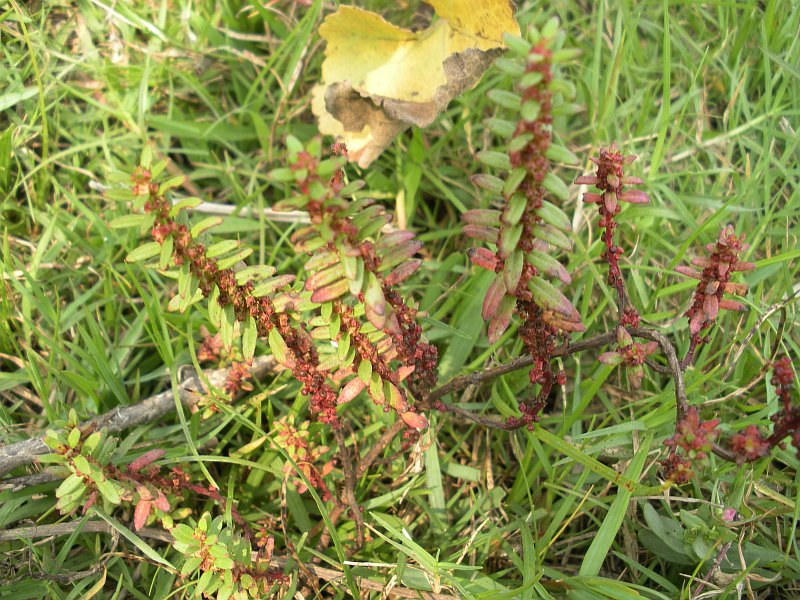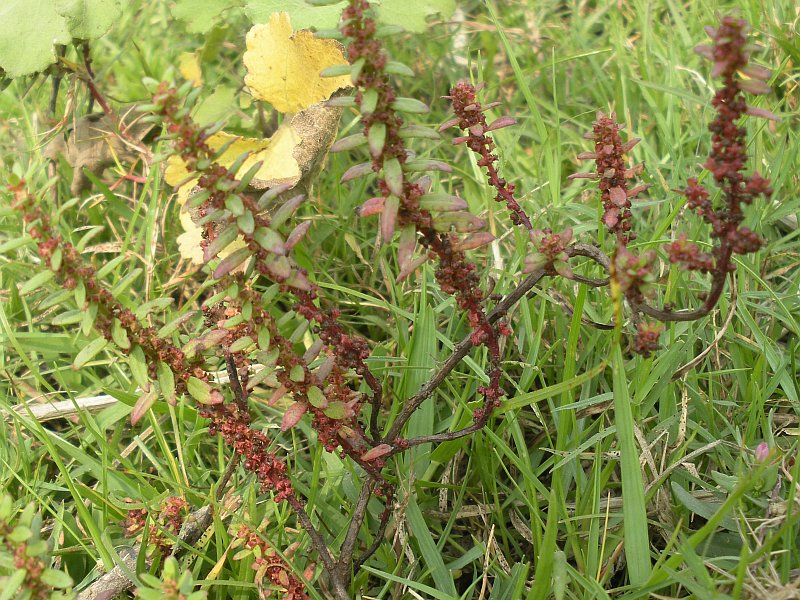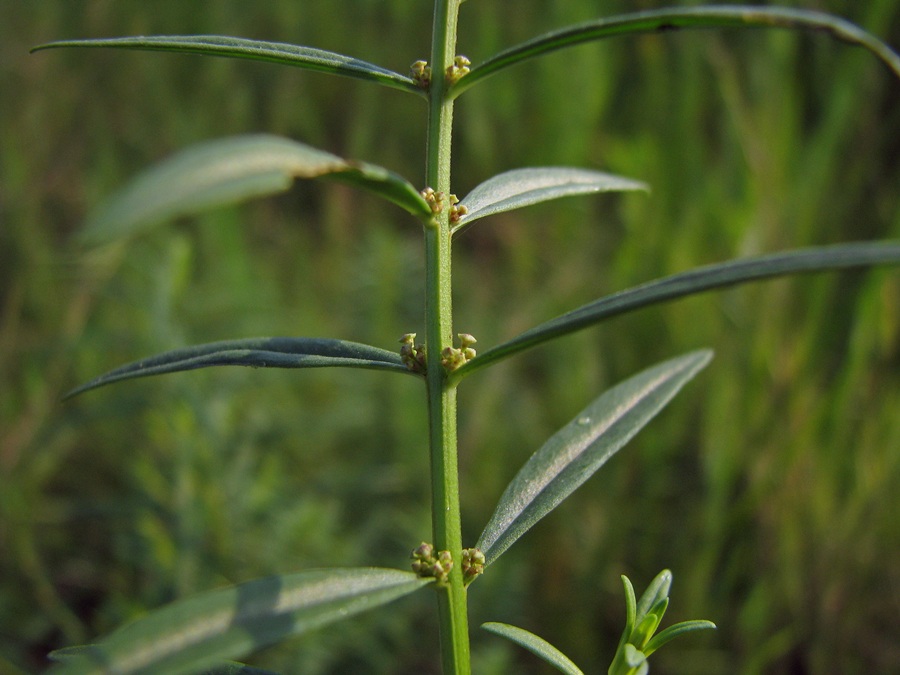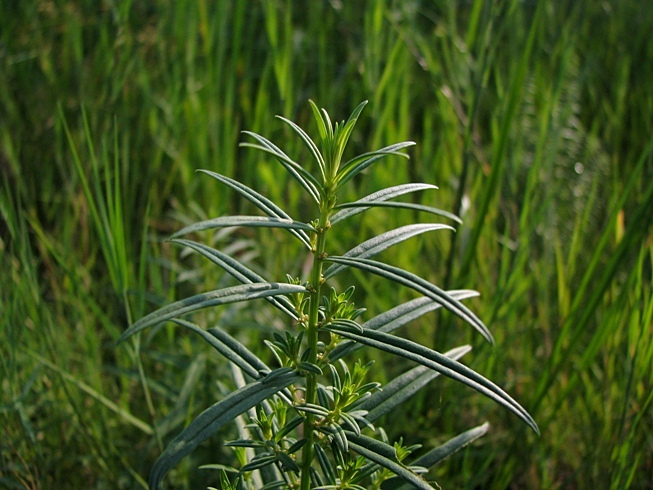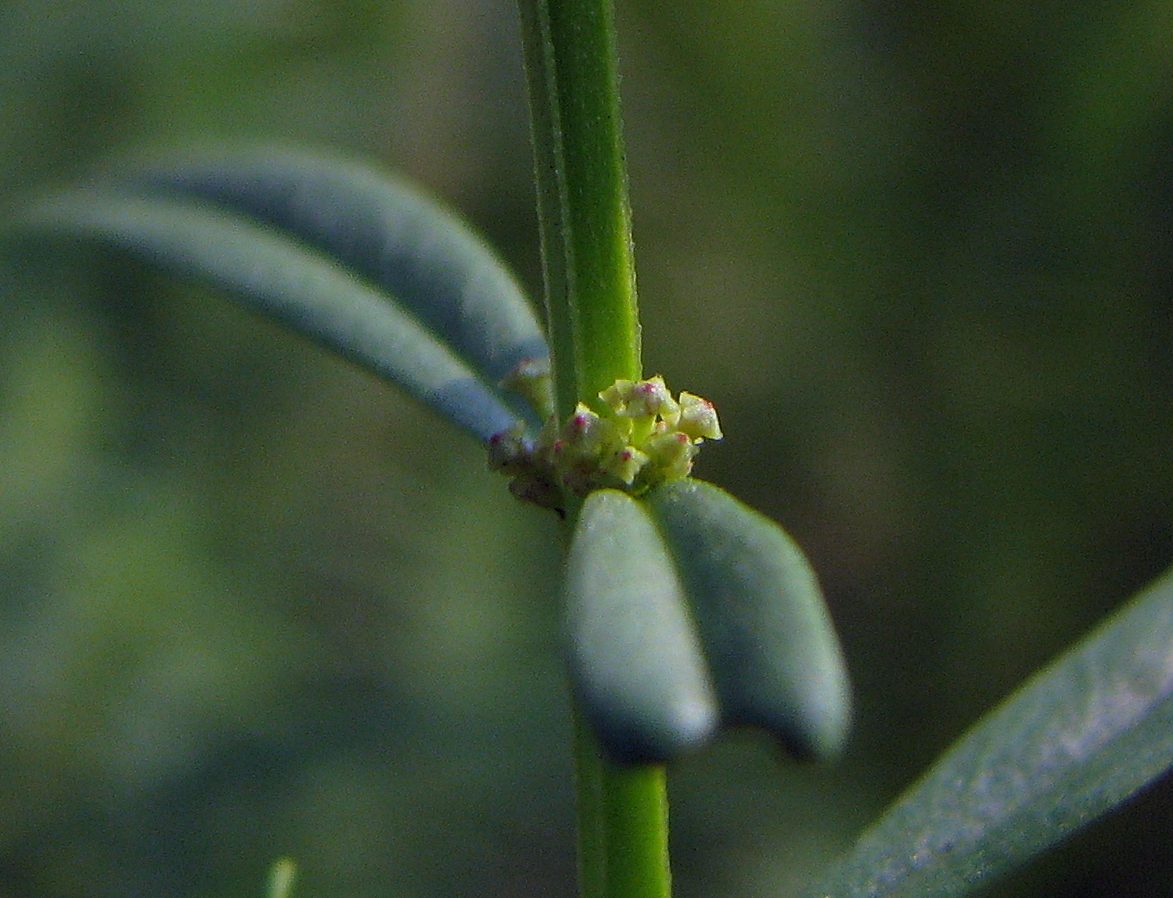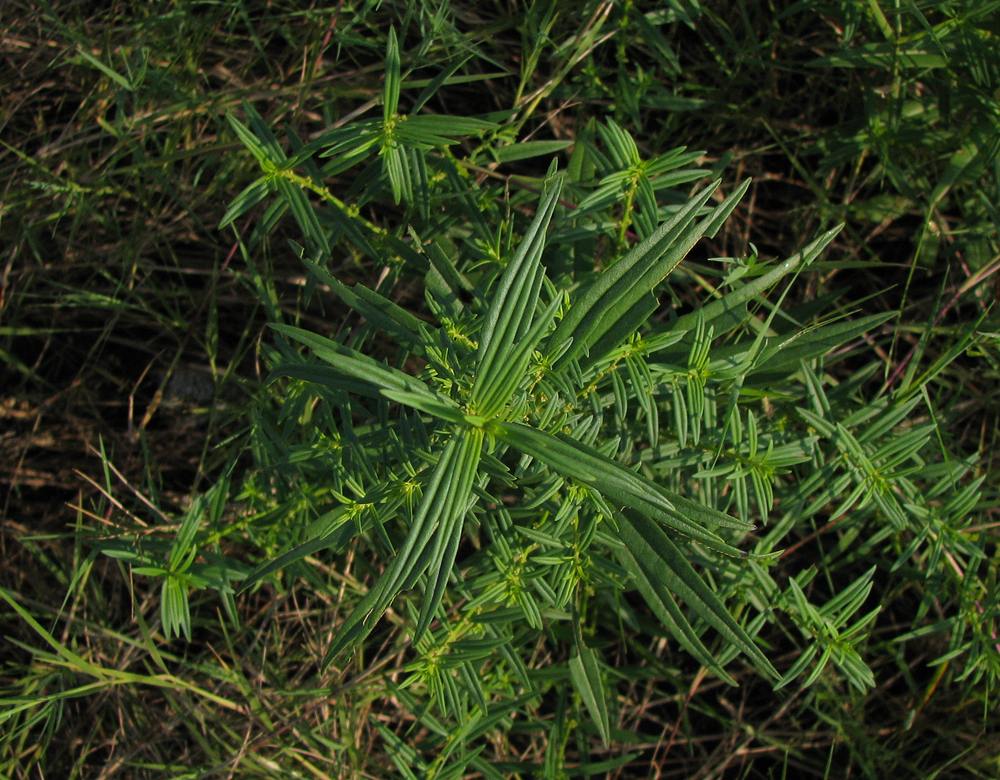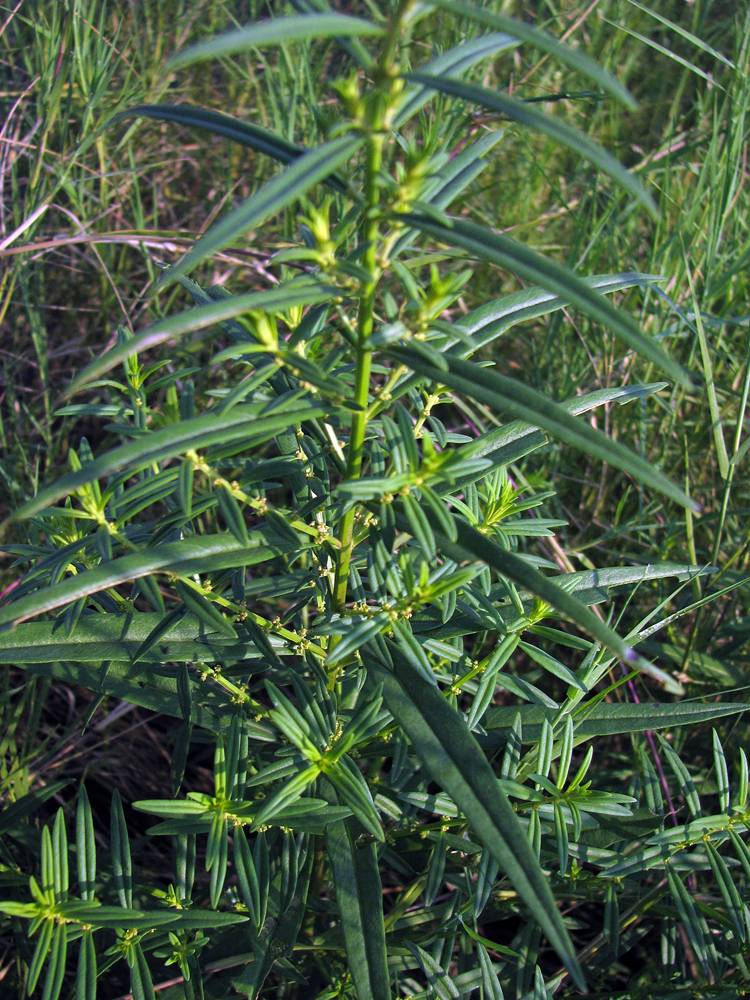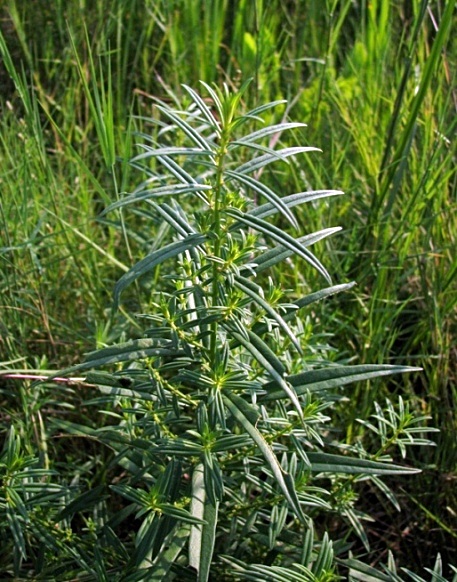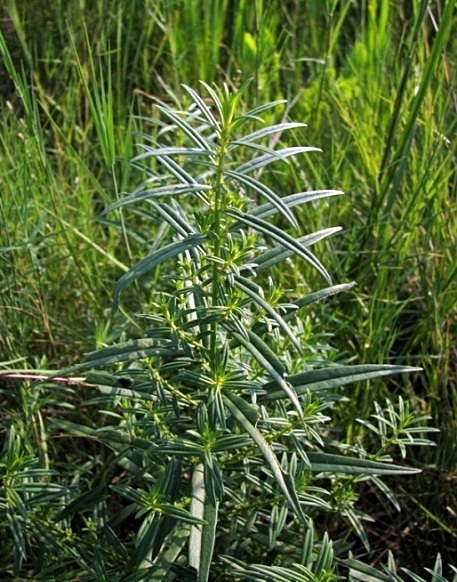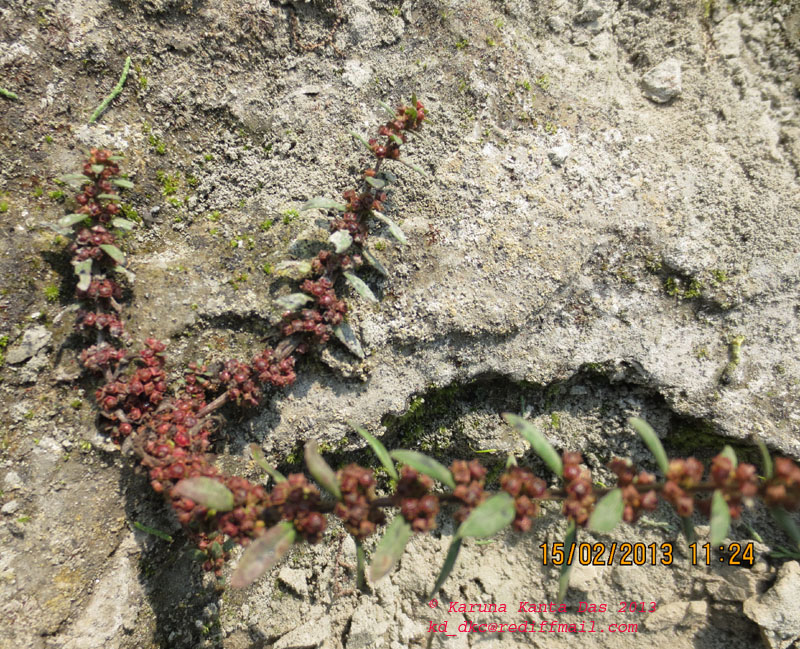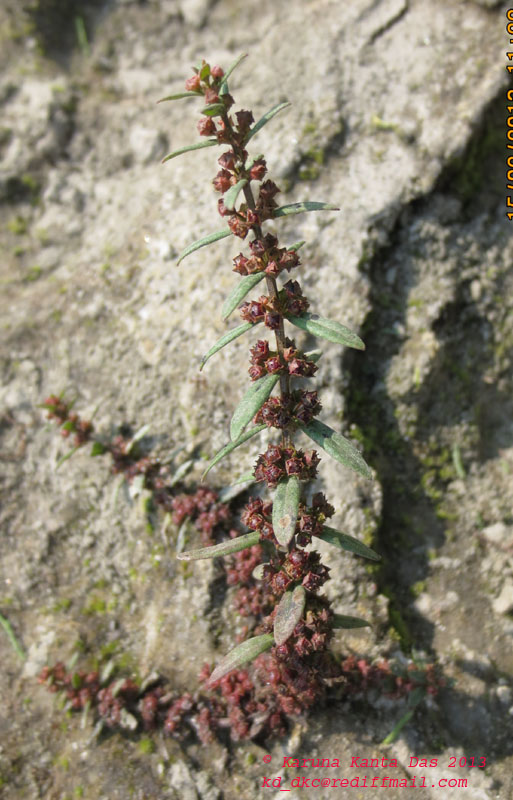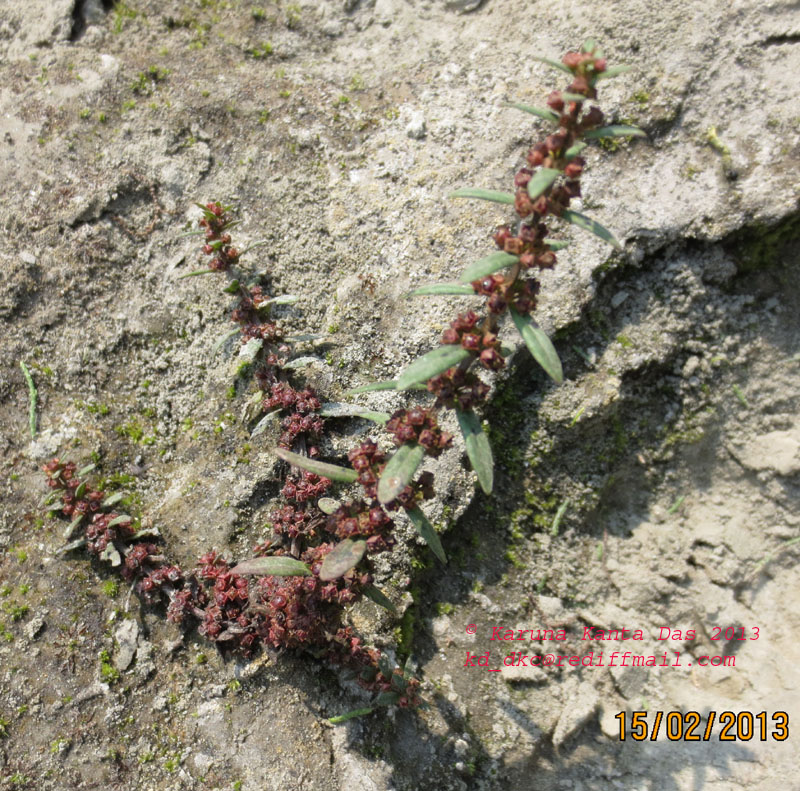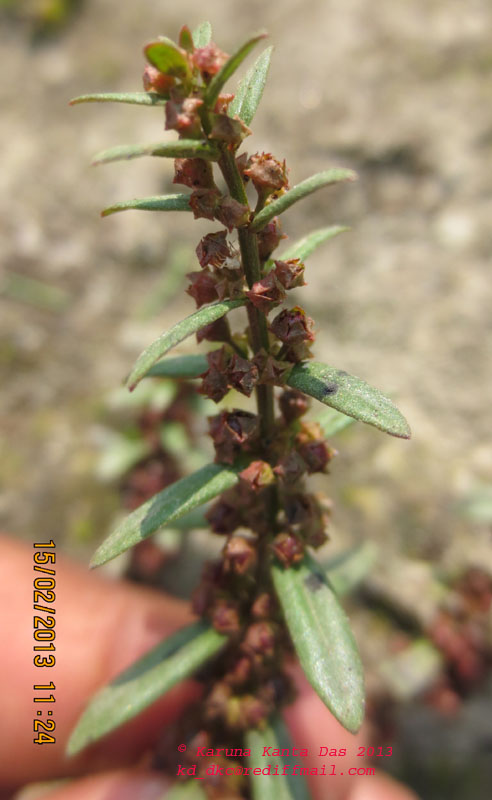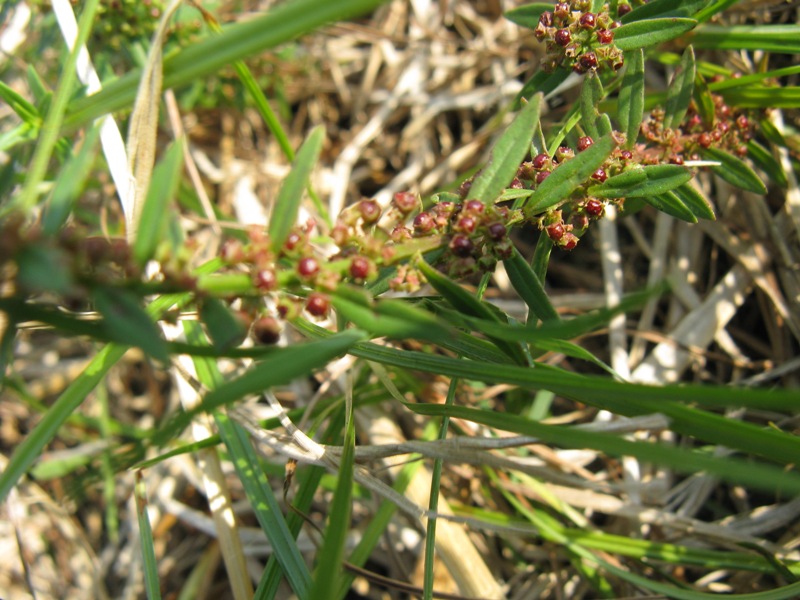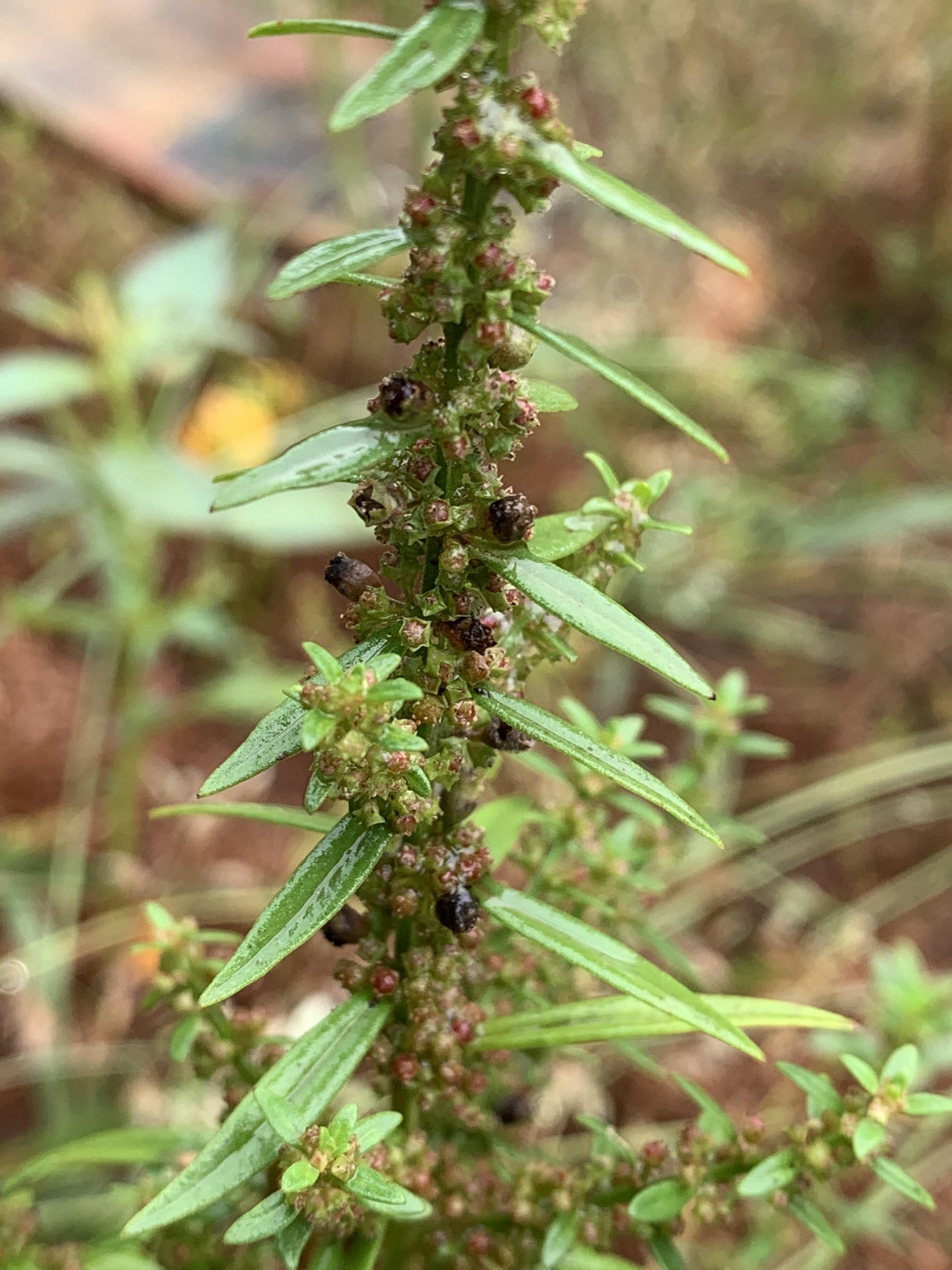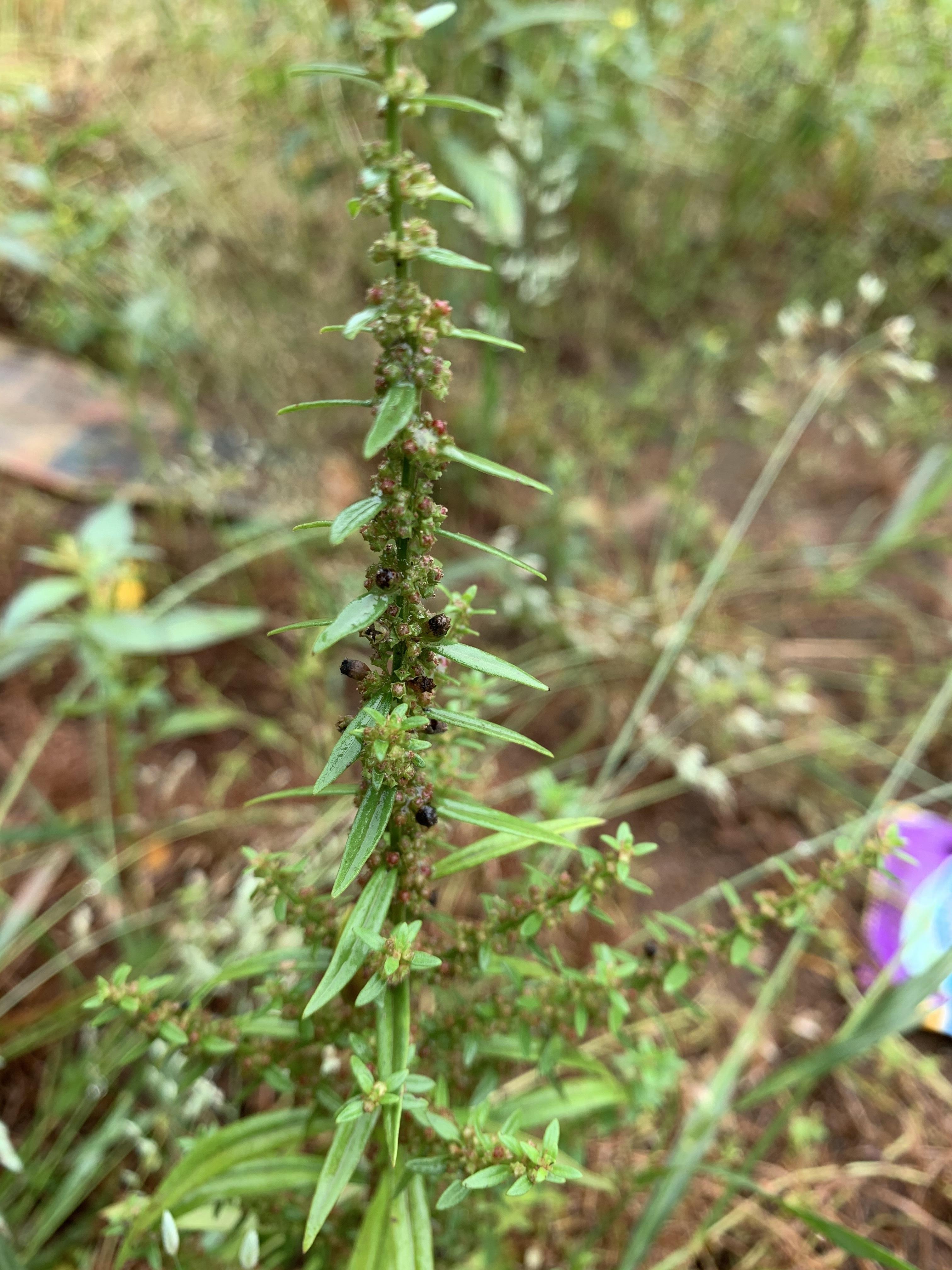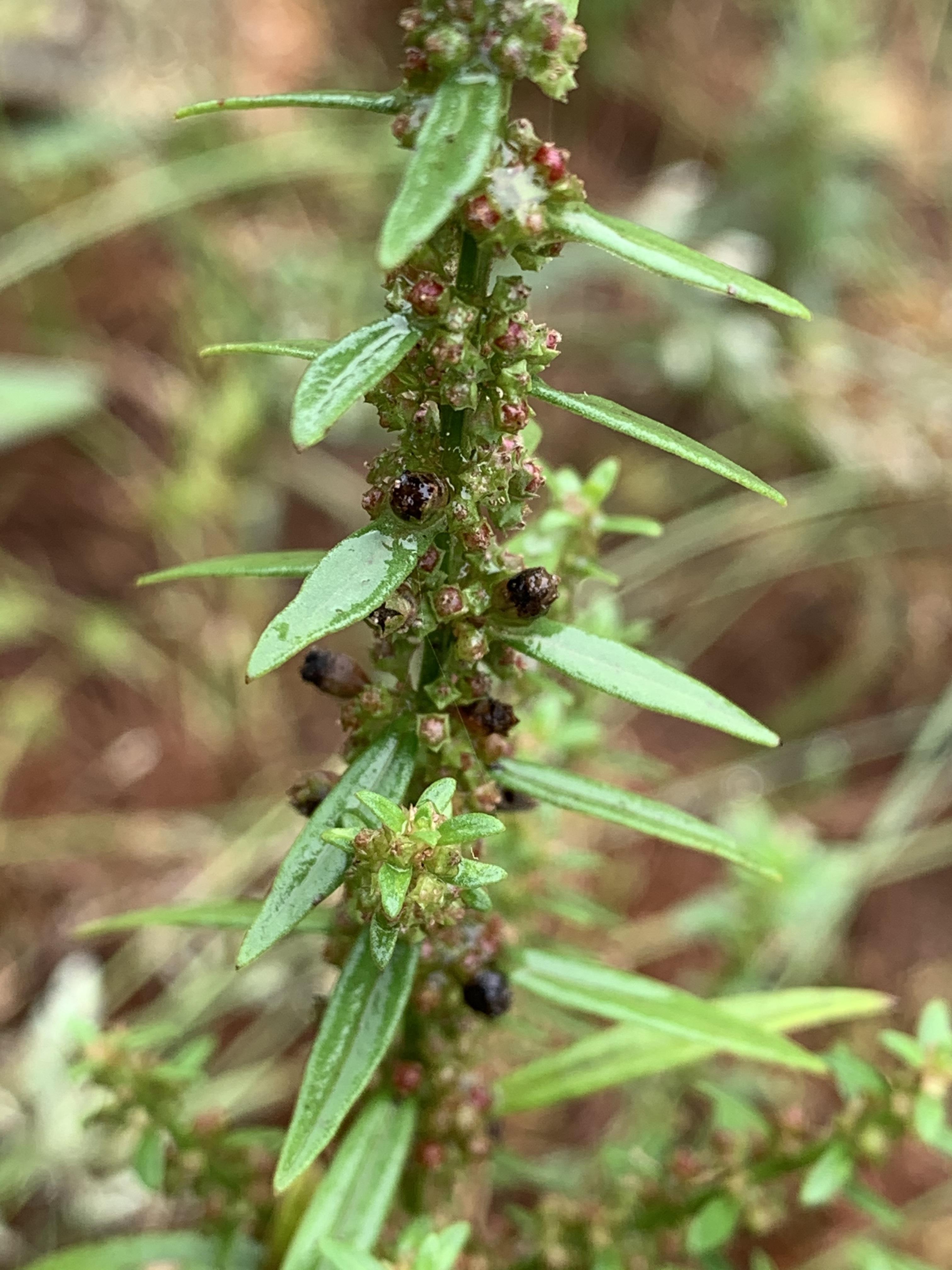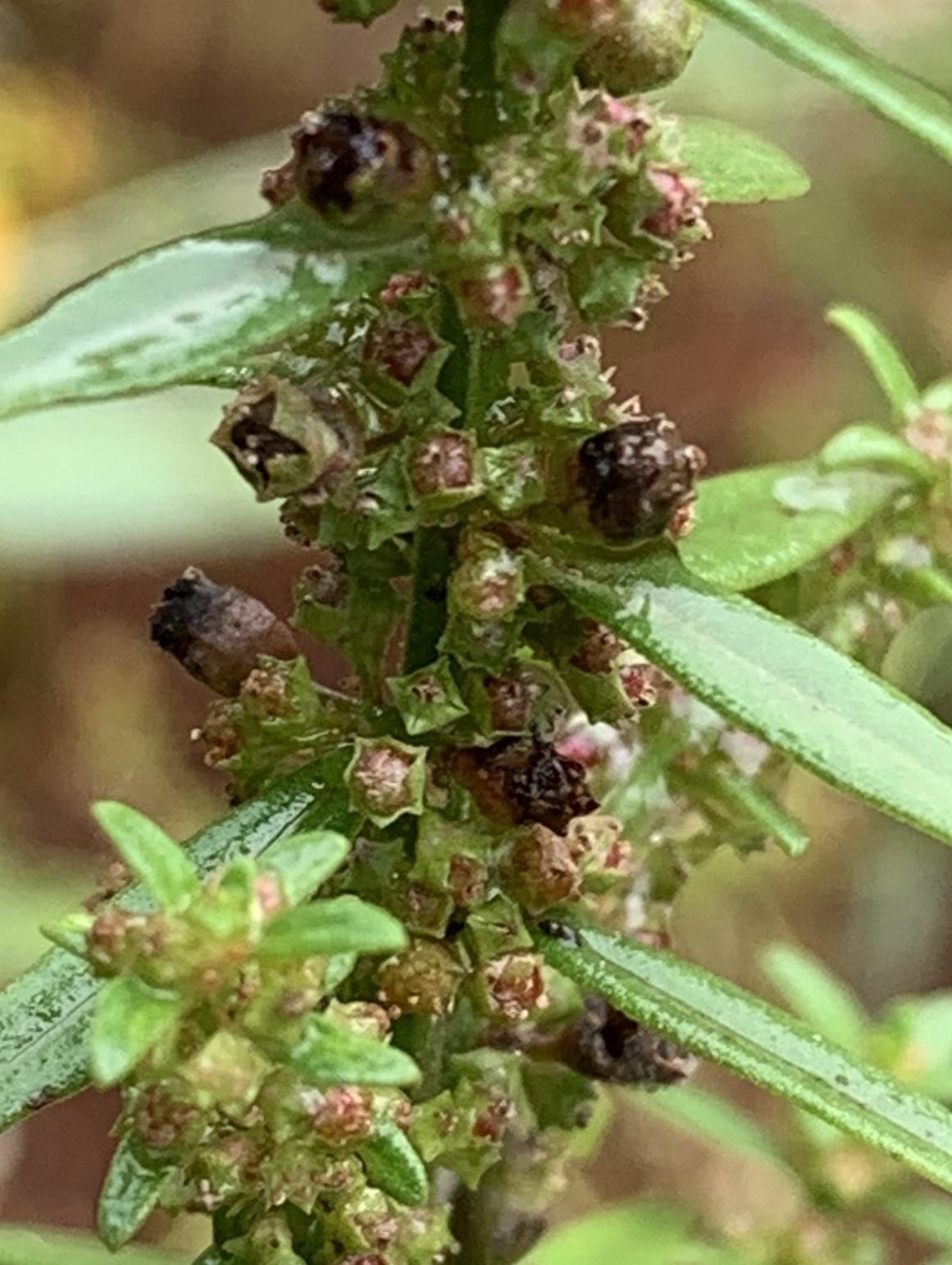|
Ammannia baccifera L., Sp. pl. 1:120. 1753 (Syn: (=) Ammannia aegyptiaca Willd.);
. As per efi thread:
Here below I have listed the differences briefly … Ammannia baccifera ssp. baccifera
cymes peduncled epicalyx minute capsule exceeding calyx tube Ammannia baccifera ssp. aegyptiaca cymes sessile-subsessile epicalyx horn-like capsule included within the calyx .. ammannia, acrid weed, blistering ammania, monarch redstem, tooth cup • Bengali: বনমরিচ banmarich • Hindi: अगिन बूटी aginbuti, बन मिरिच ban mirich, दादमारी dadmari, जंगली मेंहदी jungli mehendi • Kannada: ಕಾಡುಗಿಡ kaadugida • Konkani: दादमार्या dadmaria • Malayalam: kallur vanchi, nirumelneruppu • Marathi: अगीनबुटी aginbuti, भरजांभूळ bharajambhula, दादमारी dadmari • Nepalese: अम्बार ambar • Punjabi: dadarbooti • Sanskrit: अग्निगार्भ agnigarbha, ब्राह्मसोम brahmasoma, क्षेत्रभूषा kshetrabhusha, क्षेत्रवशिनी kshetravashini, महाश्याम mahasyama, पाषाणभेद pasanabheda • Tamil: கல்லுருவி kal-l-uruvi • Telugu: అగ్నివేండపాకు agnivendapaku;
.
Erect annual herbs to 40 cm tall; stem 4-angled or more or less winged. Leaves decussate, sessile, 2-6 x 0.5-0.8 cm, linear to elliptic, base attenuate, apex acute, chartaceous. Cymes dischasial, axillary. Flowers 4 or 5-merous, perigynous; pedicels c. 2 mm long. Calyx tube 1-2 mm long, campanulate; lobes 4, 1-1.5 mm long, triangular. Petals absent. Stamens 4; filaments c. 0.5 mm long. Ovary c. 1 mm in diam., globose, 4-5-locular; ovules many; stigma capitate. Capsule 1.5-2 mm across, globose, exceeding calyx tube. Seeds brownish, concavo-convex. Flowering and fruiting: September-December
Paddy fields and other wet lands
Tropical Africa, Asia, Europe and Australia
(Attributions- Dr. N Sasidharan (Dr. B P Pal Fellow), Kerala Forest Research Institute, Peechi
.
Ammannia baccifera is a tropical species with a range that covers the tropical parts of Asia (India, Sri Lanka, Afghanistan, Pakistan, China, Philippines, etc.), America and Africa. In the Mediterranean region it is present in Egypt and reaches its northwestern distribution limit in Turkey, Israel, and Palestine. It is naturalized in Spain.
. Please help id this small herb: This is Ammannia baccifera of Lythraceae. Does the baccifera also have a variety with greenish flowers? This is another common herb in uncultivated land. I am sorry that i couldn’t get any better picture.
Species : UNKNOWN
Habit & Habitat : wild herb, about 1 foot high, uncultivated land
Date : 17-03-12, 9.38 a.m.
Place : Gobra (Hooghly), WB Ammania baccifera. This is common in Mysore also near the water tanks. Does the Ammania baccifera looks like this attached picture, taken today (07-05-12), when the season is over?
Or is this the Rumex dentatus as in – efi thread ? The attached picture is of Rumex dentatus as in – Your last image is Rumex dentatus, very much distinct from Ammania in its very large leaves, spreading branched inflorescence and winged fruits. ID Request- 29092012-PKA2: … could be Ammannia baccifera (family: Lythraceae). Thanks … It does look like Ammannia baccifera. Date :15.02.2013
Location: Kamrup district
Family : Lythraceae
Genus & species : Ammannia baccifera L.
Habitat: Grows wild on bank of the river.
Habit: Herb :
Flower :Small
Ammania baccifera on FOI: … many thanks for validating and pointing the oddity. You must be correct too. I (partially!) agree with both of your views. This is very interesting. Here are my photographs of A. baccifera from Tikkar Tal Lake, Morni, Haryana. It looks very similar to second photograph. Could you kindly give the differences between A. baccifera and A. octandra, Taking it (3 images above) as Ammannia aegyptiaca Willd. as per keys provided by Dinesh ji in the discussions at FOR VALIDATION :: Ammannia baccifera L. :: Waghbil, Thane, Maharashtra :: Sep 27, 2008 · JUN23 DV106 I meant the attached image in this link: Just for record, here is my (herbarium photograph) from Kashmir.
Mumbai, MH :: Rotala (??) for ID :: ARK2020-028 : 5 posts by 4 authors. Attachments (4)
Saw this tiny plant in a marshy area in Charkop, Mumbai, MH in October 2019.
I suspect this is some Rotala.
Requested to please provide ID Ammania sp. ?? It’s Ammannia only, Ammannia baccifera. Usually floral elements are red, but if looked for, all green plant can be found. This is one such plant, now with mature fruits showing some red.
Small Plant for ID : Nasik : 03DEC20 : AK-04: Ammannia baccifera Roth ?? I too agree with … 06062013 ASP 41 : Attachments (1). 2 posts by 2 authors.
Can you please ID this small plant with red leaves and flowers. Photo was taken in a park in Sri Lanka in Oct 2011
Ammannia sp. I guess this should be Ammania baccifera ! . Swamy/New series/ID/21- ID of the plant Ammania sps: 1 image. I guess Ammannia baccifera L. ! Ammannia baccifera
FOR VALIDATION :: Ammannia baccifera L. :: Waghbil, Thane, Maharashtra :: Sep 27, 2008 · JUN23 DV106: 2 images. I guess the ID is correct. need to know differences between A. baccifera and A. aegyptiaca before we decide ID of this also. I have attempted to make some notes from the internet.
Most of the sites have merged – ssp. aegyptiaca with ssp. baccifera – thus was difficult to find separate descriptions.
Here below I have listed the differences briefly …
Ammannia baccifera ssp. baccifera
cymes peduncled epicalyx minute capsule exceeding calyx tubeAmmannia baccifera ssp. aegyptiaca cymes sessile-subsessile epicalyx horn-like capsule included within the calyxHere below are descriptions cited from two sites … Ammannia baccifera ssp. baccifera Kerala Plants Erect annual herbs to 40 cm tall; stem 4-angled or more or less winged. Leaves simple, decussate, sessile, 2-6 x 0.5-0.8 cm, linear to elliptic, apex acute, base attenuate, chartaceous. Cymes dischasial, axillary. Flowers 4 or 5-merous, perigynous; pedicels c. 2 mm long. Calyx tube 1-2 mm long, campanulate; lobes 4, 1-1.5 mm long, triangular. Petals absent. Stamens 4; filaments c. 0.5 mm long. Ovary 1 mm in diam., globose, 4-5-locular; ovules many; stigma capitate. Capsule 1.5-2 mm across, globose, exceeding calyx tube; seeds brownish, concavo-convex.The genus Ammannia L. (Lythraceae) in Egypt Erect or procumbent, branched herbs, up to 40 cm high; leaves narrow oblong-lorate, 3-4 cm length, 0.6-0.8 cm width; leaf base at lower leaves attenuate, at upper leaves obtuse or cuneate; cymes peduncled, lax; flowers pediceled; hypanthium 1-1.5 mm length and width, ribs obscure; epicalyx minute; petals absent; stamens 4, yellow; capsule reddish yellow, 1-1.5 mm diameter, exceeding hypanthium, style length up to 0.5 mm; seeds 0.5 mm, brownish.Ammannia baccifera ssp. aegyptiaca Kerala Plants Annual herbs, often red, erect or ascending, simple or branched, 2-80 cm tall; stems 4-angular or ± winged. Leaves opposite, 0.7-7 x 0.15-1(-1.6) cm, linear to elliptic, narrowed to the apex, narrowed to a cuneate base or obtuse or subcordate. Cymes (1-)3- many-flowered, ± lax to dense; peduncles 1 (-2) mm long; pedicels 1-2.5 mm long; bracteoles linear-lanceolate. Calyx-tube turbinate-campanulate, 1-2 mm long; lobes 4, broadly triangular, 1-1.5 mm long; intermediary appendages absent or very inconspicuous. Petals absent. Stamens 4, as long as the calyx-lobes or shorter. Ovary globose, 0.7-1.2 mm in diameter; style 0.1-0.3 mm long. Capsule globose, 1-2.5 mm in diameter, 1/2-3/4 included within the calyx; seeds brownish, concavo-convex, 0.4 mm in diameter. The genus Ammannia L. (Lythraceae) in Egypt In this posted observation of Ammania baccifera,
I see peduncled cymes; and the leaf base as attenuate-cuneate, compared to ssp. aegyptica which has a sub-cordate base.
I will wait for those who are familiar with genus Ammannia for the sake of their study, to validate this ID.
I have suggested ID based merely on my thinking. . Lythraceae: Ammannia baccifera L.: 2 images.
. References: |
Ammannia baccifera
Updated on October 16, 2025

